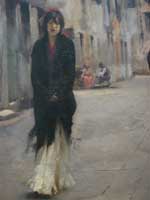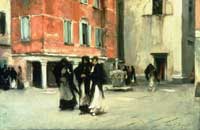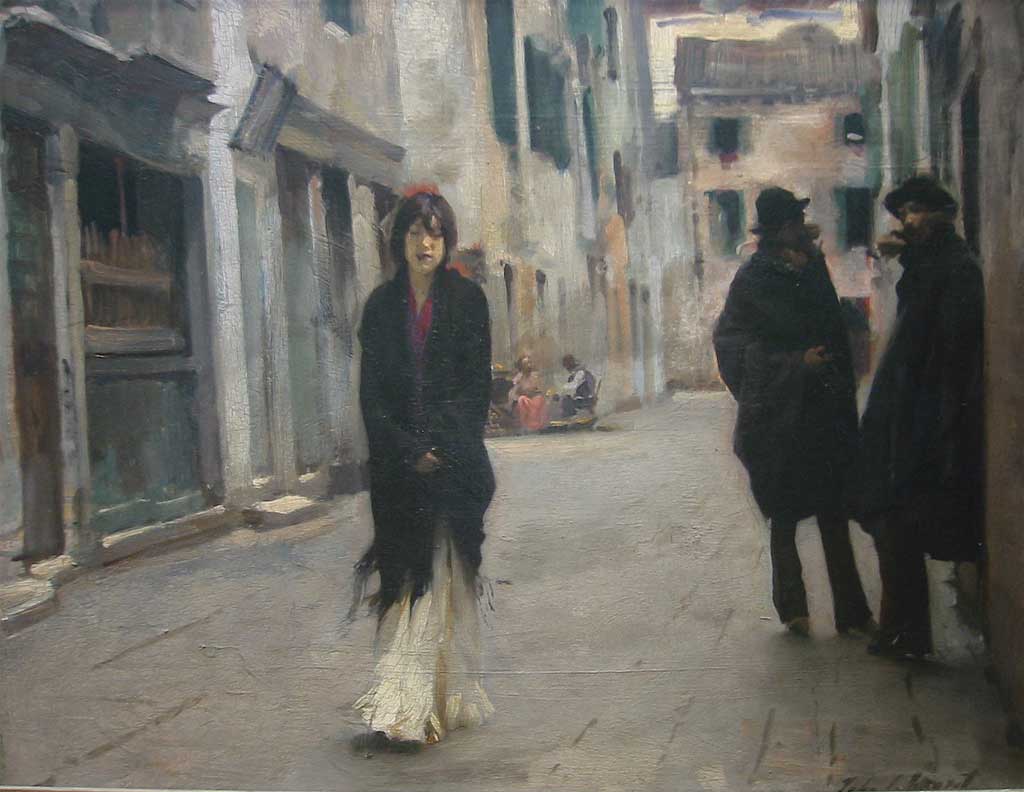Street
in Venice
John Singer
Sargent -- American
painter
1882
National
Gallery of Art,
Washington, D.C.
Oil on wood
45.1 x 53.9 cm
(17 3/4
x 21 1/4 in.)
Gift of the
Avalon Foundation
Jpg: Local / Piedmont
Fossil
(click on the
image to step
closer)
 Street in Venice Closeup
Street in Venice Closeup
Natasha,
My daughter
has the Sargent
print: Street in Venice. . . We both are generally people who
see
the glass half full rather than half empty and I viewed the young girl
as a nice young girl returning home after a late night party and dance.
Although my daughter thought she is a prostitute. Maybe so but in all
of
Sargent's paintings I never saw the seamy side of life. . .
Alan L.
Caldwell[1]
The cup is half full,
Alan. I
have little doubt that what we see here is Venice, not in how the
tourist
might see it, but in how the locals see it in everyday life in the year
1882.
This is street-life
on a chilly day
in the fall or winter with men in top coats and the woman in a warm
wrap,
on an old narrow street with locals who talk to their neighbors.
The National Gallery of Art, where this painting hangs, indicates this
was painted at Calle Larga dei Proverbi, a back alley north of the
Grand
Canal and behind the church of SS. Apostoli (Linda
Ayres, Patricia Hills Book, P. 56). They seem to
think
it was painted during siesta because, as you can see, the shop doors
are
closed and there are few people on the street. Though the tonality is
very
dark, and the shadows deep, which might give it a moody  feeling,
the subject is far from what the mood might indicate. If you compare Sortie
de l’église, Campo San Canciano, Venice (1882) with Street
in Venice you will see women headed home (from church no less) in
roughly
the same outfit as the young woman in Street in Venice.
This
is what women wore and how they wore it. feeling,
the subject is far from what the mood might indicate. If you compare Sortie
de l’église, Campo San Canciano, Venice (1882) with Street
in Venice you will see women headed home (from church no less) in
roughly
the same outfit as the young woman in Street in Venice.
This
is what women wore and how they wore it.
I am reminded of a
famous photograph
of a street in Paris in the 1940's which showed a beautiful young woman
that had passed a group of young men all of whom are admiring her. Boys
will be boys -- though I’m not sure it’s politically correct to say
that.
Remember, Sargent is 26 years old when he paints this, and I don’t
think
it beyond him to also enjoy the sight of a beautiful woman in a
fleeting
moment.
But more
importantly, I think you
need to keep in mind that this was done in the vernacular of the great
Spanish Master Diego Velazquez (1599-1660), whom John admired
greatly
and was influenced by.
In 1629, at the age
of 30, Velazquez
took a trip from Spain to Italy and studied the masters and painted
there
for two years. He visited, among other places, Venice, Florence, and
Rome.
in 1882, Sargent
travels to Venice,
Florence, Siena, and Rome at a relatively similar time in his life, and
I don't think this was lost on him. During this period, Sargent is
actively
studying and experimenting with the great Master's form and style. What
Velazquez was able to captured was the deep, deep tonality of earthy
colors,
almost monochromatic in some cases, and the ability to freeze or
capture
the instantaneousness of people, of expressions, of movement. Velazquez
was living at a time when the Spanish empire was near bankrupt and
beginning
to crumble and his paintings could be often moody in a dark tonal sense
In 1883, Sargent
sent A Street
in Venice to the Societe Internationale des Peintres et Sculpteurs,
Rue de Seze, Paris. One critic called Sargent's work "banal and
worn-out".
M.
Sargent leads us
into obsure squares and dark streets where only a single ray of light
falls.
The women of his Venice, with their messy hair and ragged clothes, are
no decendents of Titian's beauties. Why go to Italy if it is only to
gather
impressions like these.
Arthur Baigneres,
critic for the
Gazette des beaux-arts; Ratcliff, Carter, John Singer Sargent.
Abbeville
Press, New York, 1982.
This is the real
Venice
on a cool autumn or winter day. And knowing Sargent, though it might
not
be pretty at first impression, it is probably a very accurate depiction
of local life.
Notes
Exhibitions
Sargent's
Women, Adelson Galleries, New York, 2003
Forum
1) The question
from Alan Cadwell
is paraphrased from the following forum entries.

From: Alan L.
Caldwell
9/7/99
Natasha,
My daughter has the
Sargent print: Street
in Venice. . . I'm a person who sees the glass half full rather
than
half empty and viewed the young girl as a nice young girl returning
home
after a late night party and dance. My daughter thinks she is a
prostitute.
Maybe so but in all of Sargent's paintings I never saw the seamy side
of
life. . .What could your insight tell me about this.
From: Natasha
Date: 9/7/99
Alan, take a look
at my re-write
on (above).
From: Alan
Date: 9/20/99
Natasha, I informed
my daughter of
your wonderful analysis of the "Street in Venice" and she was really
happy
my version was more correct. Although she had
picked wrong she, too, is a half full glass young lady. I think I saw
there
were post cards available with that painting but I wonder if there are
prints available. If
so, I would
be interested in information about them - size
and cost.
Alan
From: Natasha
I bet she is at
that Alan, and I
paraphrased your meaning.
What interested me
about your question
was that when I fist saw this painting I, like your daughter, thought
she
might have been a prostitute. So it got me thinking -- there might be a
lot more people out there thinking the same thing.
You can order 11" x
14" from The
National Gallery for very reasonable.
|






